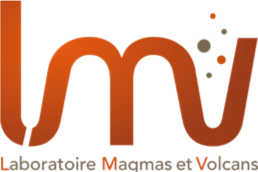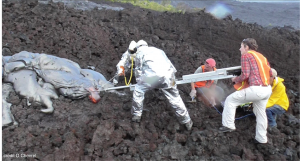The LMV has a space of 100 m² + storage + control room reserved for experiments on volcanic flows (pyroclastic flows, debris avalanches and resulting tsunamis) and on magma intrusions.
-
Contact : Olivier Roche
1 – Channel for fluidised granular flows
2 – Channel for continuous granular flows
3 – Device for measuring basal stresses in granular flows
Principales publications
Chédeville C., O. Roche (2014). Autofluidization of pyroclastic flows propagating on rough substrates as shown by laboratory experiments. Journal of Geophysical Research–Solid Earth, 119: 1764–1776.
Roche O. , Y. Niño, A. Mangeney, B. Brand, N. Pollock, G. Valentine (2013). Dynamic pore pressure variations induce substrate erosion by pyroclastic flows. Geology, 41: 1107-1110.
Roche O. (2012). Depositional processes and gas pore pressure in pyroclastic flows: an experimental perspective. Bulletin of Volcanology, 74: 1807-1820.
-
Contact : Thierry Menand
In order to understand the mechanics and dynamics of magmatic intrusions, we carry out laboratory-scale analogue experiments in which a fluid (the magmatic analogue) is injected into a gelatin solid (the analogue of the surrounding rocks) whose mechanical properties (elastic modulus, density, temperature), structure (bedded or unbedded, with or without pre-existing faults), and ambient stress field (lithostatic, or subjected to compressive or tensile stresses) are controlled. Different fluids are injected depending on the study: air to simulate highly buoyant magmas, aqueous solutions of various viscosities to study the effect of the viscosity of the magma, or vegetable oil with a solidification temperature higher than the laboratory temperature to study the effects of cooling and solidification of magmas during their flow. The injection conditions (pressure or constant flow) are controlled throughout the experiments. We mainly use dimensional analysis to process the experimental results and deduce the scaling laws that control the mechanics and dynamics of magma intrusions at geological scales.Experimental set-up for the study of dykes and sillsExamples of analog models: propagation of a sill (top view) with partial cooling of the injected fluid (black) in the case where solidification effects are low or high. In both cases, the fluid is continuously injected at constant flow.
Principales publications
Daniels K. A., Menand T., (2015). An experimental investigation of dyke injection under regional extensional stress. Journal of Geophysical Research – Solid Earth vol.120, p.2014-2035, doi:10.1002/2014JB0110627.Chanceaux, L., and Menand, T. (2014). Solidification effects on sill formation: An experimental approach. Earth Planet. Sci. Lett., 403, 79-88, doi: 10.1016/j.epsl.2014.06.018.Le Corvec, N., Menand, T., and Lindsay, J. (2013). Interaction of ascending magma with pre-existing crustal fractures in monogenetic basaltic volcanism: an experimental approach. J. Geophys. Res, doi: 10.1002/jgrb.50142.Kavanagh, J. L., Menand, T., and Daniels, K. A. (2013). Gelatine as a crustal analogue: Determining elastic properties for modelling magmatic intrusions. Tectonophysics, 582, 101-111, doi: 10.1016/j.tecto.2012.09.032.Menand, T., Daniels, K. A., and Benghiat, P. (2010). Dyke propagation and sill formation in a compressive tectonic environment. J. Geophys. Res., 115, B08201, doi:10.1029/2009JB006791.Kavanagh, J. L., Menand, T. and Sparks, R. S. J. (2006). An experimental investigation of sill formation and propagation in layered elastic media. Earth Planet. Sci. Lett. 245, 799–813.Menand, T. and Tait, S. R. (2002). The propagation of a buoyant liquid-filled fissure from a source under constant pressure: An experimental approach. J. Geophys. Res. 107 (B11), 10.1029/2001JB000589.Menand, T. and Tait, S. R. (2001). A phenomenological model for precursor volcanic eruptions. Nature, 411, 678–680. -
Contact : Raphaël Paris
Within the framework of the ANR RAVEX project (leader: Olivier Roche), the LMV has acquired a channel dedicated to the study of tsunamis generated by pyroclastic flows. This device, unique in the world, was inaugurated in January 2019.
Video presentation of the set-up on the UCA YouTube channel.


Example of a tsunami experiment generated by a fluidised granular flow:
-
Contact : Oryaëlle Chevrel
The first rotary field viscometer was designed in the 1980s and 1990s at the Lancaster University. This viscometer was recovered, restored and calibrated at LMV in 2016. It was used for the first time in 20 years in Nov. 2016 at Kilauea in Hawaii. The results have been published (Chevrel et al. 2018) however the instrument has been set aside as it is too bulky, technologically obsolete and lacking accuracy.
A new, more manageable and technologically advanced version was manufactured at the LMV in 2017-18 (declaration of invention filed in February 2019) thanks to the support of the ANR LAVA project and the incentive actions of the OPGC. The first high-temperature tests were carried out in a furnace at 1170 °C (collaboration with the association Les arts du feu). The first field measurements will be carried out as soon as the volcanic conditions allow it.
-
Intruments
– channel for fluidised granular flows (2005)
– channel for continuous granular flows (2012)
– channel for tsunami simulation (2018)
– devices for turbulent two-phase flows (2015)
– tank for analogical experimentation of magmatic intrusions (2012)
– Fastcam SA3 high-speed camera (2008)
– Fastcam Mini AX 200 high-speed camera (2018)
– ICSensor 0-35 kPa pressure sensors (2006 and 2018)
– Kistler 0-2 kN force transducers (2012)
– contact transducers Olympus V153 (2018)
– contact transducers Olympus C133 (2016)
– VBA-100-110W Vectorwave amplifier (2019)
– ultrasonic Pulser JSR DPR 300 (2016)
– Iso-Tech IDS 1054B oscilloscope (2018)
– large volume oven (2004)
– high flow air compressor (2015)
– tank for IR imaging of granular suspensions (2016)
– thermocouples (2016)














